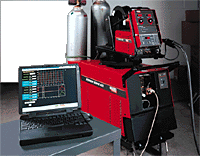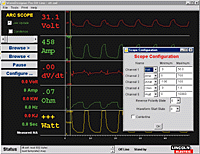Pulsed MIG Welding

Advantages provided by pulsing machines include:
Wire and gas savings
Pulsed MIG machines offer a wider operating range because they extend the low and high range of each wire diameter. For instance, before the operator would have to stock .035”, .045” and .052” wire diameters for varying applications, but with Pulsed MIG, .045” can be extended on the low end and top end range so that it can be used for a variety of applications. What this means is that rather than having two or three different sized wires, an operator would only require one. Having one wire type minimizes inventory costs and reduces changeover times. The same is true with shielding gas – one gas can reach both the low and high ranges of the application. In addition, the different types of spare parts (gun, gun tips, liners, etc.) are decreased for additional cost savings.
Spatter and fume reduction
Compared to Conventional MIG, Pulsing offers reduced spatter and fume. Reduction in spatter translates into significant cost savings because more of the melted wire is applied to the weld joint, not as surface spatter on the product and surrounding fixtures. This also means less clean-up time. A reduction in the welding fumes creates a safer and healthier environment for the entire plant or shop.
Heat reduction
Pulsing offers controlled heat input leading to less distortion and improved overall quality and appearance which means fewer production problems. This is especially important with stainless, nickel and other alloys that are sensitive to heat input.
Improved productivity
Pulsed MIG offers high deposition rates. In addition, since the new machines are simpler and adaptive, it is easier to weld with pulsed MIG than other transfer methods, less time is spent training.
Better quality
All these advantages of Pulsed MIG outlined above result in overall better quality of the finished and a more stable arc. In addition, operators are receiving a better quality working environment since they are not dealing with fume, spatter and extra clean-up or grinding time. One more benefit is that synergic power sources allow for these high quality welds to be achieved by those with relatively less training.
What is Pulsed MIG?

The pulsed MIG process works by forming one droplet of molten metal at the end of the electrode per pulse. Then, just the right amount of current is added to push that one droplet across the arc and into the puddle. The transfer of these droplets occurs through the arc, one droplet per pulse.
To understand this process in detail, let’s take a look at a waveform. Unlike CV (constant voltage) where current is represented by a straight line, pulsed MIG drops the current at times when extra power is not needed, therefore cooling off the process. It is this “cooling off” period that allows pulsed MIG to weld better on thin materials, control distortion and run at lower wire feed speeds.
During the process, the current rises to a peak when the droplet is formed. Then, in the background current phase, the current is lowered to reduce the overall heat input. It is the height and the width of the peak that is important for proper transfer.
Pulsed MIG Compared to Other Transfer Methods
How does pulsed MIG compare to other welding transfer modes? We will examine each with their advantages and disadvantages.
Short Circuit
In short circuit, the wire touches the work piece and shorts to itself. This is the coldest form of welding that still offers good fusion. Short circuit allows operators to weld on both thick and thin material in all positions. It also has the benefit of a small, quickly solidifying puddle. Its disadvantages include limited wire feed speed, and deposition rates. There is also a danger of “cold lapping” on thicker metals. This is where there is not enough energy in the puddle to fuse properly. Short circuit also produces an increased amount of spatter over the other transfer methods.
Globular
The globular transfer mode is basically uncontrolled short circuit. It is characterized by a large volume of weld metal coming off the electrode. These large droplets are pinched at the arc and drop into the puddle. This method of transfer produces a tremendous amount of spatter as well as high heat input. Also, globular is limited to flat and horizontal fillet welds. Less fusion is often common because the spatter disrupts the weld puddle. Also, because globular transfer uses more wire, it is generally considered less efficient.
On the positive side, globular transfer runs at high wire feed speeds and amperages for good penetration on thick metals. Also, it can be used with inexpensive, CO2 shielding gas. It is used mainly when appearance is not an issue.
Spray Arc
Spray arc propels small molten droplet of the electrode to the work. It is a pure CV process that must produce enough current to send a constant stream of metal off the electrode. Its advantages include high deposition rates, good penetration, strong fusion, good weld appearance with little spatter.
Its disadvantages include high heat input, a limited range of welding positions and proneness to burnthrough on thin materials.
Pulsed MIG
Pulsed MIG is an advanced form of welding that takes the best of all the other forms of transfer while minimizing or eliminating their disadvantages. Unlike short circuit, pulsed MIG does not create spatter or run the risk of cold lapping. The welding positions in pulsed MIG are not limited as they are with globular or spray and its wire use is definitely more efficient. By cooling off the spray arc process, pulsed MIG is able to expand its welding range and its lower heat input does not make burnthrough on thin metals a problem. Pulsed MIG is one of the best welding processes for a wide variety of applications and metal types.
Customization of the Waveform
To take the pulsed MIG process a step further, Lincoln Electric offers complete customization of the welding waveform through its state-of-the-art Waveform Control Technology®. This technology allows the power source to be finely tailored to the wire and process. The power source rapidly adjusts the pulse waveform for superior welding performance. It does this by providing a fast or slow front edge on the pulse to transfer the droplet at the proper rate, the back edge then falls at a controlled rate to add the heat needed to wet the droplet to the puddle. With Waveform Control Technology®, built-in templates are set up in the power source for standard usage on a variety of materials. Variables such as ramp rate, peak time, tailout, step off, among others are controlled in a precise manner so that when there is a process set-up change, there is a corresponding change in waveform configuration.
Equipment Selection
Pulsed MIG welding has evolved quite a bit since it was first introduced to the marketplace. In the 1980s, it was a highly complex process that could only be performed by the most skilled welders. That was because the operator would have to know exactly how to set the machine for the correct wire feed speed to perform this type of welding. Today, this is all done for him or her as part of the synergic control. When the operator adjusts wire feed speed, the synergic operation adjusts the waveshape and frequency automatically.
The synergic operation of the machine makes it easy to use, even for the beginning welder, with a single knob that controls all operations. In addition, its sophisticated internal electronics are even “adaptive” to adjust for variations in stickout, gap or the torch angle.
Here are some tips to help operators choose which equipment to use for Pulsed MIG:
1. Choose equipment capable of operating over the new expanded range of welding processes
If an operator was previously welding with a 300 amp CV machine, it shouldn’t necessarily be assumed that he must select a 300 amp Pulsed MIG machine. Because of the wider range of operating capabilities with Pulsed MIG, an operator may be able to jump to a 400 amp machine that has the higher amperage capabilities to handle the expanded wire feed speed ranges.
2. Look for advanced synergic controls
As was stated before, advanced synergic machines offer simple user interfaces that will result in less training time for new users.
3. Consider investing in dual procedure guns
Because Pulsed MIG affords a wider operating range, it might make sense to invest in dual procedure guns. These are guns that easily allow the operator to flip between procedure pre-sets on the machine. Make sure though that the wire feeder is capable of running this dual procedure gun.
4. Carefully choose welding gun size
Because the Pulsed MIG process can go out to higher ranges and have high current pulses, it may run “hotter” than previously used MIG processes. For this reason, an operator should choose a larger, possibly water-cooled welding gun that is sized for the appropriate current.
5. Look for work voltage sensing if welding far from the power source
Some power sources have a work voltage sensing option that improves pulsing performance as distance is placed between the work site and the power source. Normally the machine senses the voltage at the output studs – one at the work and the other at the wire feeder. With this option an operator can run a separate lead out to the work.
Set-Up Tips
Set-up for Pulsed MIG machines is a little different than Conventional MIG machines. Take care to ensure that the appropriate guidelines are followed for safe operation.
1. Higher pulse currents require a better ground
The user must make sure that he or she has a good electrical path before welding.
2. Cable lengths should be minimized to reduce inductance
Cable lengths should be kept under 50 ft. as a general rule. Wherever possible, only use the length of cable you need – coiling up the extra creates inductance. Inductance smoothes out the pulses and reduce their effectiveness. Also, care should be taken to keep cables together without big loops or looping around conductive objects. These factors will result in better performance specifically in Pulsed MIG.
Conclusion
Cost savings, better quality, improved productivity and easier operation…all these factors make Pulsed MIG an option that should not be overlooked. Although the high price tag may scare you, carefully weigh the initial investment with the benefits that will be derived over the long term. Take advantage of the new technological advantages provided by Pulsed MIG – one machine to handle virtually any application, flawlessly.
